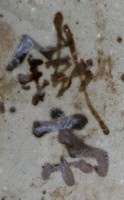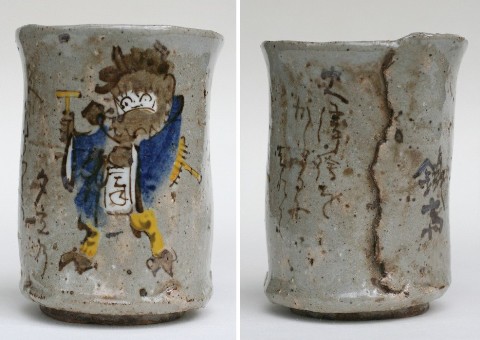Nanga
Winter chawan, teacup - oni no nembutsuSigned: Tessai
Seals:
Technique: Kiyoyaki grey earthenware from Kyoto with coloured underglaze painting and calligraphy Ø 8 x 10
Condition: fine
The oni no nembutsu is a motif of the Ôtsu-e, pictures from Ôtsu, sold as amulets to travellers on the Tokaidô. It represents a demon chanting Buddhist invocations. These pictures were purchased in the belief that they would prevent babies from crying at night.
Tomioka Tessai was the last great exponent of the Nanga School. He was born in Kyoto into a family selling robes and accessories for the Buddhist clergy. As a result of a childhood illness he became partly deaf, and his parents decided he would never be a successful shopkeeper. He went to study the Japanese classics in order to become a Shinto priest. As a youth he met Ōtagaki Rengetsu (1791-1875) and became her special protégé. She taught him waka and encouraged his artistic inclinations. In the final years of the Tokugawa era Tessai was involved in the imperialist movement. For fear of being arrested he left Kyoto in 1861 and travelled to Nagasaki. In 1882 after many trips he settled in Kyoto where he spent the rest of his life. Although he worked as a priest at several Shinto shrines, he saw painting as his chief occupation. Between 1894 and 1904 he was a teacher at the Kyoto Prefectural Art School founded by Tanomura Chokunyû (1814-1907). He was a regular contributor to exhibitions of Chokunyû’s Nanga Society. In 1917 he was appointed Artist to the Imperial Household and towards the end of his life he received an honorary court-rank.
Reference:
Kanazawa
Kato 1998
Roberts p. 181
Araki pp. 2754-2755
Aburai pp. 266-267
Morioka & Berry ‘99 pp. 116-121
Morioka & Berry ‘08 p. 305-06
Price: SOLD

